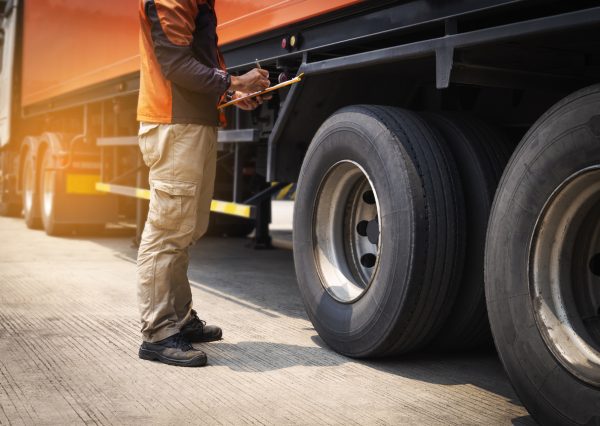
Accidents involving commercial trucks represent some of the most costly claims for businesses. A fleet safety program is a coordinated initiative that combines safety technology with ongoing coaching to improve driver behaviour, reduce accidents, prevent false claims, and lower costs.
A fleet safety program designed specifically for your company can help establish procedures and policies that ensure a safe work environment while protecting you from liability and costly claims. In fact, Harvard Business Review claims there are 48% fewer safety incidents at companies with strong safety cultures. Without an official program, you are putting your driver’s safety — and your organization — at risk.
Regardless of the size of your fleet, an ongoing process of screening, testing, inspection and training offers a number of advantages, including improved safety, efficiency and employee satisfaction. In this post, we will examine how the right combination of hardware, software and high-level organizational acumen can create a comprehensive safety program for your fleet, so you can focus on building your business.
What to know about creating a fleet safety program
Commitment to a safety program starts from the top-down. Your drivers won’t buy-in if you don’t sell safety as a top priority. A comprehensive, current fleet safety program should become part of your corporate culture, and should be absorbed by everyone who gets behind the wheel of one of your vehicles.
Define your goals
A fleet safety program can’t succeed if you haven’t identified key pain points, problems areas and company goals. Some organizations have a specific problem to address, such as a rise in risky driving behaviour. Reviewing all safety-related issues from the past six months (distracted driving, accidents, claims, etc.) will give you a holistic overview, and a great place to start identifying goals. Once you’ve installed your hardware solution (i.e. dash cameras), you can identify those alerts and any recurring safety issues.
Create a timeline
An implementation timeline will give you time to roll out your safety program in a way that makes sense to your organization. A timeline helps you organize your plan, engage all stakeholders and ensure that deployment is successful. Include all phases and identify key milestones to prioritize what’s most important, stay on track and make sure everyone understands their accountabilities.
Hiring
In this light, you should know everyone who drives your vehicles on behalf of your business. Screen and select your drivers carefully and make sure they represent your corporate culture and philosophy. Having clear hiring standards and a thorough screening process can help you select a top-tier roster of responsible drivers.
Training
Training your drivers properly ensures that everyone understands what is expected of them with regards to vehicle safety policies and procedures. Ongoing training and management keeps everyone current on safe driving strategies while mitigating accidents when they occur. Make sure written policies and procedures are accessible to everyone and are kept up-to-date on a regular basis. Learning never ends, and neither should your training policies.
Maintenance
All vehicles used by your employees must be maintained in compliance with Ontario’s Highway Traffic Act. Creating an official plan for repairs, maintenance and regular vehicle inspection will help reduce costly repairs, unexpected breakdowns and accidents due to vehicle issues. Conversely, you can get a maintenance schedule from the vehicle’s manufacturer.
Hardware
First and foremost, you should invest in a video-based safety solution, such as dual-facing dash cameras and telematics systems. These practices provide visibility and essential data sets that can bolster a robust fleet safety program. The National Surface Transportation Safety Center for Excellence (NSTSCE) reported that a combination of dash cams, telematics and real-time GPS tracking can reduce safety-related incidents by more than 50%.
ZenduIT’s comprehensive dash cam solutions have a number of scalable offerings that can save your business time and money, while helping you build a fleet safety program that suits your organization’s needs.
Real-time coaching
Driver coaching is most effective when combined with telematics data and real-time video footage from dash cams. Building a coaching system into your existing workflows can help improve driver behaviour, reduce accidents, and lower costs. Because some driving behaviours are riskier than others, it’s important to maximize the impact of your efforts by coaching all of your drivers on a regular basis, paying attention to those who may fall below a predetermined safety score.
Setting up alerts
Once you know which undesirable driving behaviours you want your drivers to avoid (such as harsh braking, speeding, idling or distraction) you can set up alerts on ZenduCAM’s Trax platform so you can immediately coach drivers on targeted behaviours, either by real-time SMS or email alerts. Feedback is most effective when it’s delivered in real-time or soon thereafter in order to keep incidents top of mind. Make sure to choose a ZenduIT dash cam with a built-in speaker so you can advise as events unfold.
Dash Cams
Help exonerate your drivers with front-facing and/or dual-facing dash cams that can analyze the road and your driver in real-time, then automatically upload footage to a cloud-based storage system. Real-time telematics provides you with the exact location and driving status of every vehicle in your fleet with an ELD, so that you can detect safety events like speeding or harsh braking.
Find exactly what you need, when you need it with reliable video evidence. Whether you need to gather facts about a collision, verify service, or ensure compliance, use video evidence from cloud-connected cameras to take action. Search by time, date, or event and select the clip that tells the full story so you can get back to business.
Conclusion
There are many reasons as to why fleet managers would invest in a fleet safety program. Companies with a strong safety culture typically experience a higher level of productivity and greater driver retention. As an employer you owe your workers a duty of care to keep them safe while on the road.
A fleet safety program is a long-term investment that will pay off in the form of increased accountability, greater fleet safety, fewer liabilities and collisions, and reduced operational expenses.
At ZenduIT, we use our expertise and extensive experience to help you assess risk, resolve your safety pain points, and help you design your fleet safety program to help protect what is important to your business. Contact us today!


